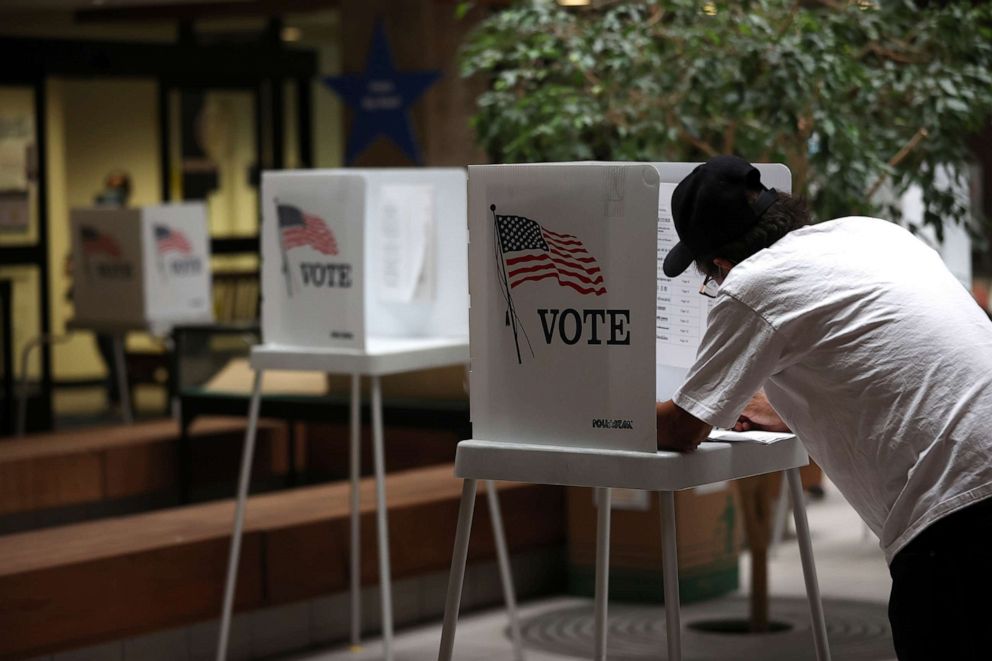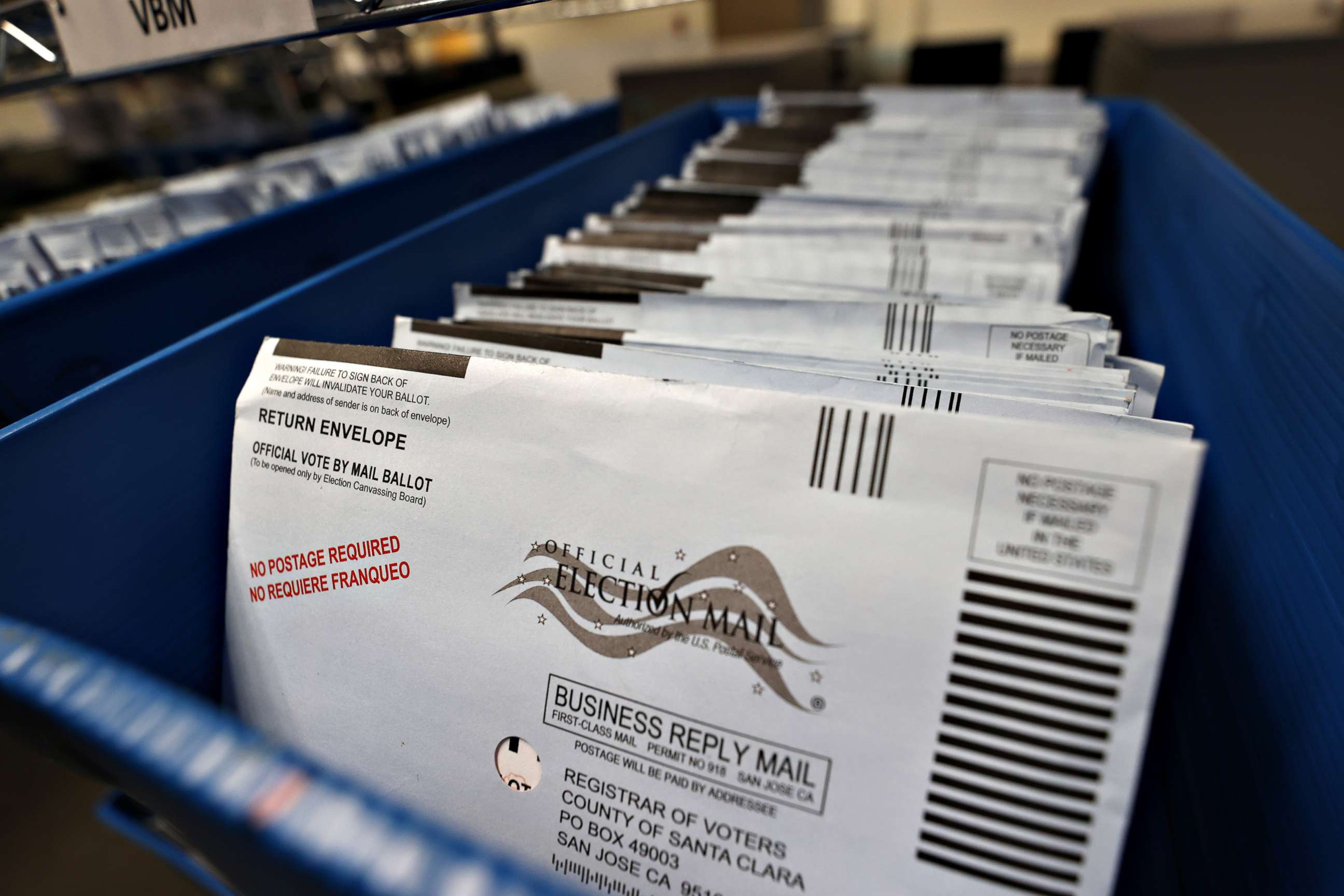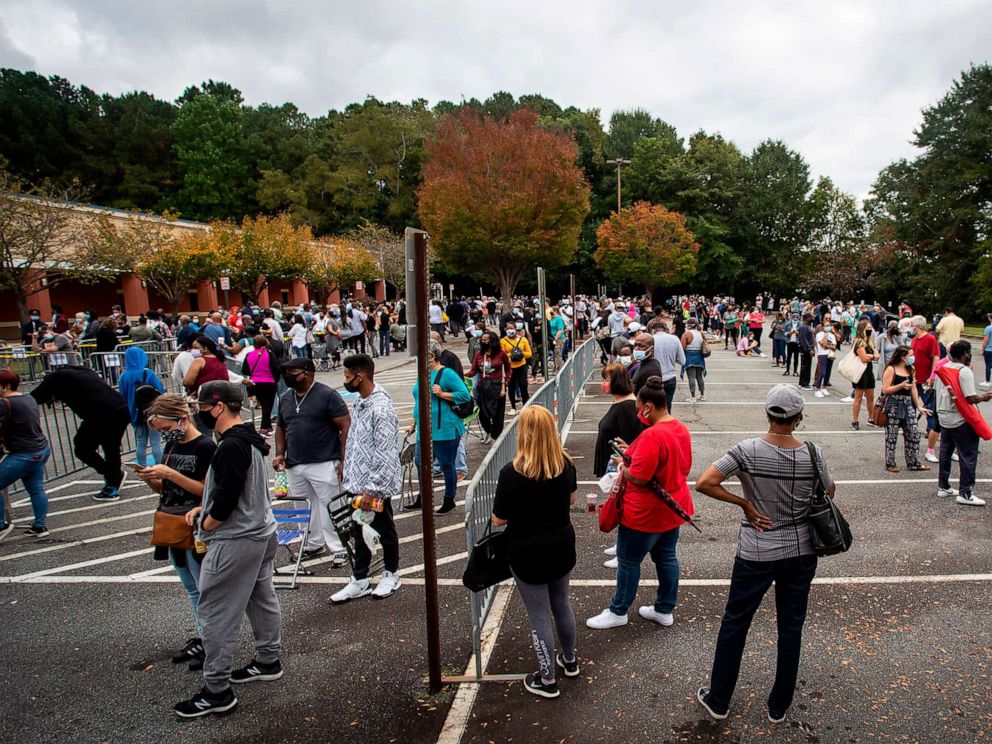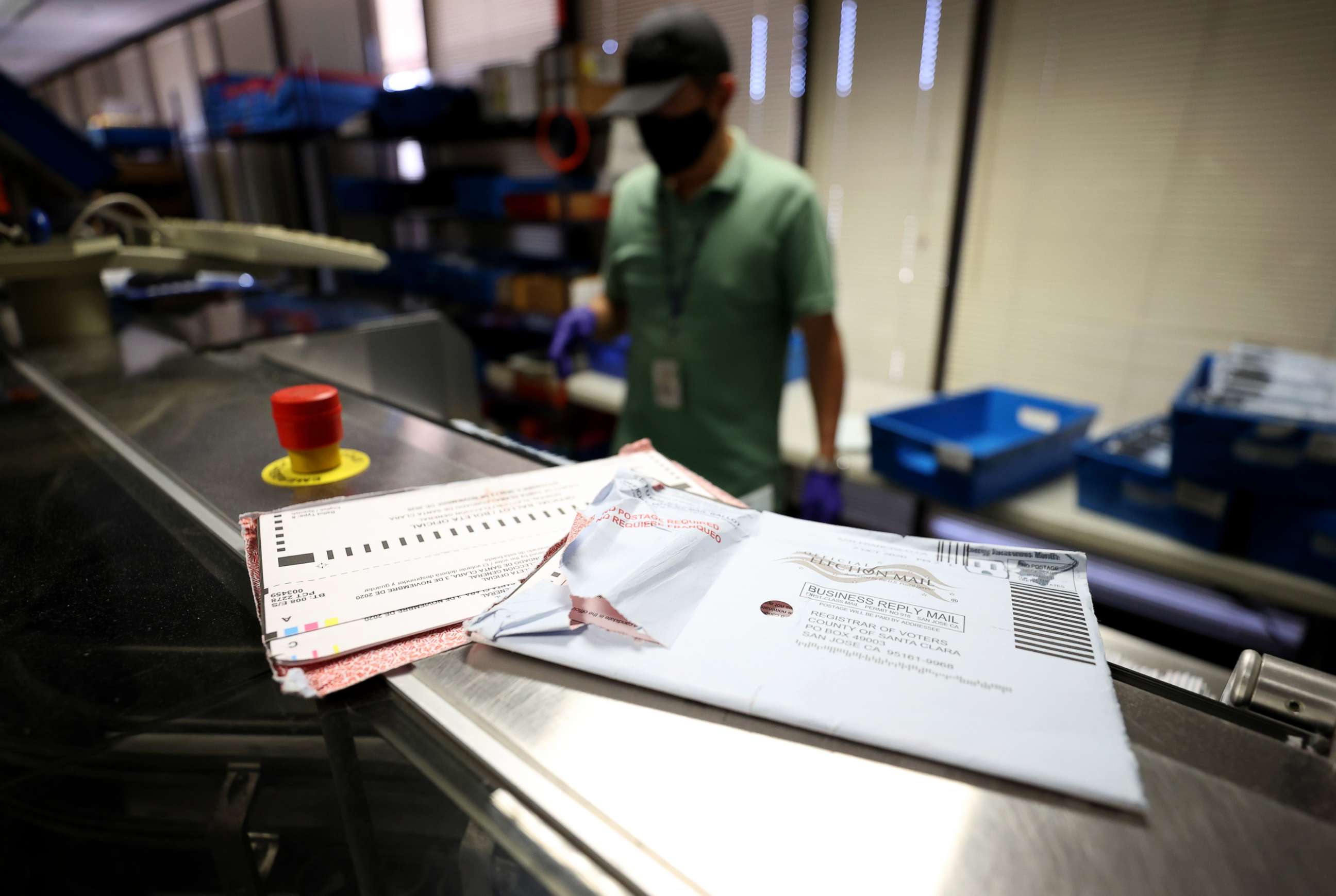750,000 mail-in ballots were rejected in 2016 and 2018. Here's why that matters.
In 2020, 81 million mail-in ballots have been requested across the country.
With the pandemic still on the rise or peaking in parts of the U.S. just two weeks from Election Day, the demand for mail-in ballots from COVID-weary voters is at an all-time high.
More than 81 million mail-in ballots across 43 states and Washington, DC have already been requested in the 2020 election, double the number in 2016 and more than half the total vote as well, according to an ABC News analysis.
But voter-rights advocates are worried that the unprecedented scale of the mail-in system this time around could translate into more ballots being tossed out than ever before, leaving hundreds of thousands disenfranchised in contests with slim margins.
While the vast majority of mail-in ballots will be cast without issue this year, as has been the case in the past, a small, but growing percentage of votes have been rejected.
An ABC News analysis of the last two election cycles (2016 and 2018), found that more than 750,000 mail-in ballots were rejected, about 1.2% of the total ballots returned, mainly for not having valid signatures and being sent in on time. More than 500,000 ballots were rejected in this year's primaries alone, the first test of the pandemic voting system, and a similar pattern appears to be emerging in the general election.
In places with close votes in the presidential contest, and especially down ballot, winning margins could be on par with the number of mail-in ballots that were counted and thrown out.
For instance, nearly 23,000 ballots were rejected during this year's primaries in Wisconsin, greater than Trump's margin of victory there in 2016, according to a report by the Wisconsin Election Commission.
“Whether or not the rejection rates are higher enough to necessarily cause the presidential election to go one way or another, there is reason to think that these could be shifting local races, like races for local district attorneys,” Kevin Morris, a quantitative researcher at the Brennan Center for Justice, told ABC News.
This is not to mention that many counties have rejection rates well above the national average. Of particular concern is the rate of rejection among voters of color and the poor, which an ABC News analysis found was higher than in counties with whiter and more affluent populations.
Jennifer Morrell, a member of the National Task Force on Election Crises and a partner at election consulting firm Elections Group, told ABC News that election officials are rapidly adapting to accommodate voters in light of the pandemic and many have not conducted elections with such a high level of mail-in vote.
“They're working out the kinks, and unfortunately, they don't have the luxury of a time or a low-profile election to work some of those out,” she told ABC News.
Lessons from 2016 and 2018
Nationwide, mail-in ballot rejection rates have been minimal during the last two election cycles, but grew– from less than 1% in 2016 to 1.4% in 2018, an ABC News analysis found. But rejection rates were considerably higher in some places, notably the South in both contests, and the Northeast in 2018.
At least 97 counties had double-digit rejection rates in 2018, including 10 or more counties in Arkansas, Kentucky, North Carolina and New York, where absentee voting has been less common.
Particularly of note were the tens of thousands of rejected ballots in New York City in 2018 -- in three New York City boroughs, at least one out of every four mailed ballots were tossed in2018. That happened again in the 2020 primary, when thousands more were rejected for technical errors. In the general election, New York sent out 100,000 ballots with incorrect names and addresses, adding to the confusion and frustration there.
On the other hand, states like Michigan, Montana, New Mexico and Oregon reported rejection rates for all counties at or below the national average in 2018, according to the Election Administration and Voting Survey (EAVS) data. Oregon, along with Colorado, is among few states that have been doing full-scale mail-in voting for several past elections.

Why were so many mail-in ballots tossed out? The biggest reason cited by local election officials is, simply, the lack of a valid signature.
ABC News analysis of EAVS data from 2016 and 2018 revealed that nearly 290,000 mailed ballots were scrapped because the voter did not properly sign the ballot, signed in a way that did not match their registration signature or did not have a required witness validation.
Signature issues account for about 57% of the more than 500,000 mail-in ballots with “identifiable” reasons for rejection in 2016 and 2018, followed by voters missing the deadline to return ballots, which accounted for about 37% of rejections.
Election officials counted a large portion of rejections in the past two elections -- more than 233,000 ballots -- 39% of all rejected ballots in 2018 and 21% in 2016 -- as “other,” or not identifiable.
Many of those disenfranchised in the last two election cycles were voters of color and poor.
ABC News’ analysis shows that mail-in ballot rejection rates were nearly 1 ½ times higher in majority non-white counties than in counties where non-white population was 10% or less.
In counties where annual median household income was less than $35,000, the rejection rate was also 1 ½ times higher than in counties where income was more than $75,000 (the median household income was $60,293 in 2018).
ABC News also found that in states that are counting mail-in ballots for the 2020 general election, similar patterns are emerging as the past two election cycles -- mismatched signatures and missed deadlines.So far this year, some states are seeing lower rejection rates, but experts say those could go up as voting ramps up.
Detailed data for this year is minimal, so we focused on the states that provided it. Experts also noted that ballot status trends shown in this year’s state-released data are murky because rejected ballots can usually be fixed and accepted until Election Day, unlike 2016 and 2018 rejections, which have been finalized.
California seeing signature mismatches, but they have a system for that
In California, a state with relatively low levels of rejection and an all mail-in system, officials explained that signatures are a particularly tricky bar to overcome in verifying voters.
"There are voters out there that their first signature we have on file is from the DMV when they got their license when they were 16," said Evelyn Mendez, the public and legislative affairs manager for the Santa Clara County, California Registrar’s Office. "It doesn't match."

California officials – who have been mass-mailing ballots for years – try to compare the mandatory signature on the back of the ballot envelope to the signature in a resident’s voter registration file.
"If, after multiple levels of computerized and human review, it is determined the comparison still isn't good, then the election official will mail you a letter saying you have an opportunity to cure your signature," explained Fresno County, California Clerk Brandi Orth.
In the March primary election, Orth said Fresno County sent out 2,544 such letters because envelopes had "no signature" or a "mismatched signature" and offered voters a chance to rectify the situation.
Only 527 ballots didn't get fixed and were never processed, Orth said -- about 0.3%.
In San Francisco County, rejections in the 2018 election boiled down to voters missing the deadline to mail in their ballots, officials there said.
While the county tossed out less than 2% of the ballots received, the vast majority of those were due to a late postmark on the ballot envelope.
"It was because ballots came late to us... we just can't count them because they didn't meet the deadline with the postmark," said John Arntz of the San Francisco Department of Elections.
Witness rules complicate voting in North Carolina
This year, in North Carolina, more than 1.3 million mail-in ballots have been requested for the November general election -- massively more than in 2016.
Bob Phillips, the executive director at the nonprofit Common Cause North Carolina, told ABC News that North Carolina has historically been one of the least active states in terms of mail-in voting, with just 3% of the voters casting ballots by mail in 2016. But this year, state election officials project that 15 to 20% of the ballots might be cast through the mail, he said.
Complicating matters is the state's witness requirements, which create more opportunities for issues with ballots and the possibility of disenfranchisement.
At least 556,000 of those ballots have been returned and accepted. More than 7,100 are still pending, which suggests there are some issues with the ballots, and6,000 have been tossed for various reasons.

According to state-released data, roughly4,500 of the ballots in this year's general election were marked as “spoiled” and discarded, which can mean anything from the voter cancelling the ballot for various reasons, to a voter requesting another ballot because the previous one was damaged.
Roughly 530 ballots, or about 0.1% of the returned ballots, were rejected for having “incomplete witness information,” suggesting that the North Carolina election law that requires a person over the age of 18 to sign the ballot as a witness has been a hurdle for some voters.
Phillips said the issue of witness signatures comes from a lack of education about the process and socioeconomic disparities in access to that voter education -- something advocates are trying to address.
“Overwhelmingly, people are doing this for the first time. They've never done it, and so naturally there are mistakes in some people's level of getting information,” he said.
Overall, white voters were least likely to have their ballots rejected in North Carolina in 2020, while Native American voters were most likely, followed by Black voters and Hispanic voters, the data showed.
In particular, Robeson County, which voted for Trump in 2016, has rejected more than 10% of its ballots this year. It's also one of the poorest and least white counties in the state, with a particularly large Native American population.
Low rejection in Georgia so far, but it’s early, experts say
In Georgia, a state with a rejection rate considerably higher than the national average in 2016, of the 1.7 million mail-in ballots that have been requested for this year's general election, roughly 675,000 have been returned.
So far, only a very small fraction of that -- just102 ballots -- were rejected, while roughly2,700 ballots were classified as "spoiled" due to voter error, invalid marking on the ballot, or damaged ballot, according to state-released data. About 88,000 were reported as canceled for a variety of reasons, including administrative cancellation, voter request and change to in-person voting.
Aunna Dennis, executive director at Common Cause Georgia, told ABC News that local voter right advocates haven't seen anything in the rejection rate that would raise red flags so far, but warned that could change as Election Day approaches.

Spaulding County, Peach County, Morgan County, Decatur County and Clay County were among counties that have seen the largest number of ballots rejected so far this year.
The most common reason for rejected ballots this year, the state data shows, were "missing signature” and "invalid signature.” Some ballots were also tossed because the voters were ineligible, missed the deadline and missed identification.
The bigger concern in Georgia, Dennis said, is the amount of time it takes for voters to receive the ballots. Dennis said this was due to the fact that the vendors who print the ballots are out of state.
But experts say whatever patterns in mail-in voting that are seen right now nationwide can look drastically different after Nov. 3.
"I expect so much to change based on what happens after Election Day,” Morris told ABC News.
Morris said voters who send their ballots in the last minute are less likely to be familiar with the process and have less time to mend their ballots if there’s a problem with the ballot, compounded by the fact that a large share of mail-in ballots are rejected every election for missing the deadline.
“I think that any rejection counters we identify now are likely to be swamped by what happens after Election Day because so many folks are going to have their ballots rejected because of that,” Morris said.
KFSN's Corin Hoggard and KGO's Stephanie Sierra contributed to this report.

